Pump Handbook by Igor J. Karassik, Joseph P. Messina, Paul Cooper, Charles C. Heald - 3rd edition
Подождите немного. Документ загружается.

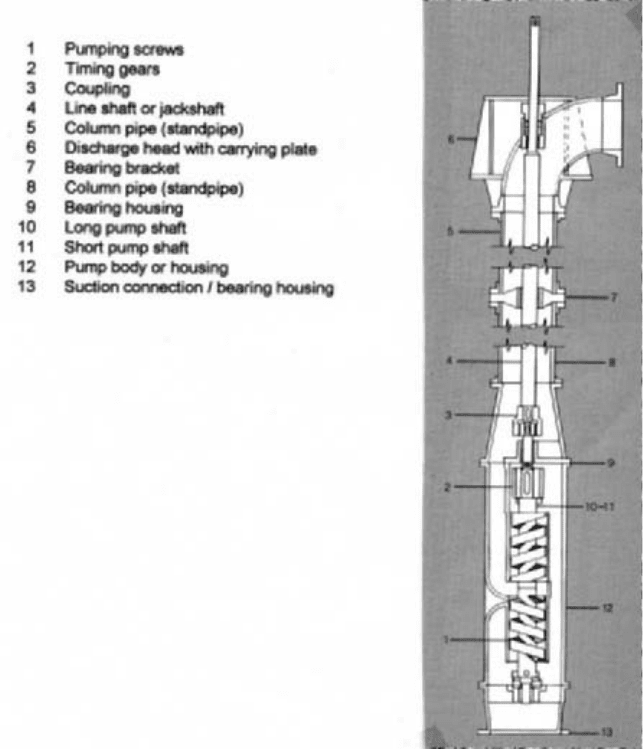
9.11 MARINE PUMPS 9.249
FIGURE 18 Deep-well screw pump (IMO-Warren Pump)
vent vapor in the vessel’s cargo tanks from flowing backwards through the inert-gas
supply piping and into the machinery spaces. It is common to use single-stage electric-
motor-driven centrifugal pumps for both of these applications.
TANK-CLEANING PUMPS On some vessels, hot seawater is used to clean cargo tanks of
residue that remains in the tanks after the liquid cargo has been discharged. A typical
tank-cleaning or tank-washing pump takes suction from a sea chest and discharges sea-
water through a heater in which it is often heated to a temperature of approximately
200°F (93°C). The hot seawater then passes through nozzles in tank washing machines
and is sprayed onto the sides of the cargo tanks being cleaned. Single- and two-stage cen-
trifugal pumps that are driven by steam turbines, electric motors, or hydraulic motors are
frequently used in this application. A tank-washing pump may also be used for other pur-
poses, such as fire fighting.
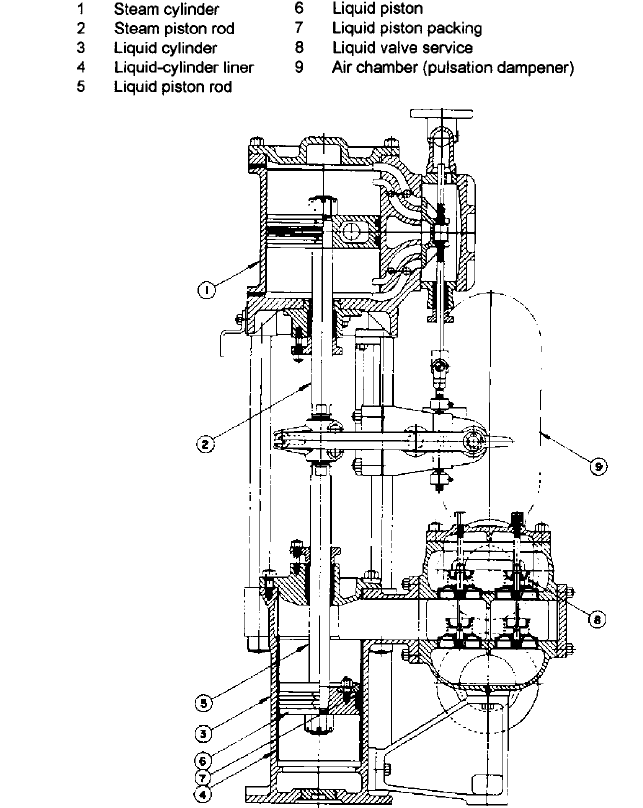
9.250 CHAPTER NINE
FIGURE 19 Duplex direct-acting reciprocating pump (Flowserve Corporation)
As an alternative to washing cargo tanks with seawater, crude carriers frequently
clean tanks with crude oil, referred to as crude-oil washing (COW).A general-service pump
is often used on a crude carrier to deliver pressurized crude oil to the vessel’s tank-wash-
ing machines. The pump may receive this oil from a holding or slop tank on the vessel.The
general service pump may also be used to deliver cargo to an eductor that strips cargo
tanks during the final stages of unloading or during crude-oil washing. This cargo, which
serves as the motive fluid in the eductor, mixes with the fluid being removed from the
cargo tank and is then usually discharged by the eductor into one of the vessel’s slop tanks.
On a typical crude carrier, the general-service pump is similar in configuration to the ves-
sel’s main cargo pumps but is smaller.
9.11 MARINE PUMPS 9.251
FURTHER READING __________________________________________________
Cowley, J., ed. The Running and Maintenance of Marine Machinery. 6th ed., Marine Man-
agement (Holdings) Ltd., London, 1992.
Feck, A. W., and Sommerhalder, J. O. “Cargo Pumping in Modern Tankers and Bulk Car-
riers.” Marine Technology. Vol. 4, No. 3, 1967.
Harrington, R. L., ed. Marine Engineering. The Society of Naval Architects and Marine
Engineers, Jersey City, NJ, 1992.
Hunt, E. C., ed. Modern Marine Engineer’s Manual. Vol. I, 3rd ed., Cornell Maritime Press,
Centreville, MD, 1999.
McGeorge, H. D. Marine Auxiliary Machinery. 7th ed., Butterworth-Heinemann Ltd., 1995.
Paashaus, R. F. “An Analysis of Cavitation Damage in Commercial Marine Condensate
Pumps.” SNAME/ASME meeting, New York, December 1964.
Sembler, W. J. “The Design and Operation of Pumps Furnished for Marine Cargo Service.”
Marine Technology. Vol. 25, No. 1, 1988, pp. 1
—
29 and No. 2, 1988, pp. 75
—
104.
Specification for Centrifugal Pump, Shipboard Use. ASTM F 998-86 (1993), American Soci-
ety for Testing and Materials, West Conshohocken, PA, 1993.
Specification for Rotary Positive Displacement Pumps, Commercial Ships Use. ASTM F
1510-94, American Society for Testing and Materials, West Conshohocken, PA, 1994.
Standard Specification for Mechanical Seals for Shipboard Pump Applications, ASTM F
1511-95. American Society for Testing and Materials, West Conshohocken, PA, 1995.

SECTION 9.12
REFRIGERATION,
HEATING, AND
AIR CONDITIONING
MELVIN A. RAMSEY
9.253
HEATING____________________________________________________________
Heat is usually generated at a central point and transferred to one or more points of use.
The transfer may be by means of a liquid (usually water), which has its temperature
increased at the source and gives up its heat at the point of use by reduction of its tem-
perature. It may also be transferred by means of a vapor (usually steam), which changes
from a liquid to a vapor at the source and gives up its heat at the point of use by conden-
sation. Pumps may be required in both of these methods.
HOT WATER CIRCULATING ____________________________________________
A centrifugal pump best meets the requirements of this service. Water is usually used in
a closed circuit so that there is no static head. The only resistance to flow is that from fric-
tion in the piping and fittings, the heater, the heating coils or radiators, and the control
valves. In selecting the pump, the total flow resistance at the required flow rate should be
calculated as accurately as possible, with some thought as to how much variation there
might be as a result of inaccuracy of calculations or changes in the circuit because of
installation conditions. It is not good practice to select a pump for a head or capacity con-
siderably higher than that required, as this is likely to result in a higher noise level as well
as increased power.
When hot water is used for radiation in a single circuit, through several radiators, the
water temperature variation is usually only about 20 F° (11 C°) at the time of maximum
requirements, so there is not too great a difference in heat output between the first and
last radiator in the circuit. With the flow rate based on water at 180° to 200°F (82 to 93°C)
to heat air to about 75°F (24°C), a 10% reduction in the flow would have little effect, as the
9.254 CHAPTER NINE
actual difference would increase to only 22 F° (12°C), and the reduction in the heat output
of the radiator with 178°F (81°C) water would be only about 2%. Reference to Section 8.1,
on the selection of pumps and the prediction of performance from the head-capacity pump
curves and system head-flow rate curves, will show that a rather large undercalculation
of circuit head loss would be necessary to produce a flow rate 10% less than desired.
Greater temperature differences are frequently used for other radiation circuits, and a
reduced flow rate may have a greater temperature differential than in the single circuit.
Whatever the condition, the pump should be selected only after full consideration of all the
factors, and not by use of so-called safety factors, which are likely instead to be “trouble
factors.”
Air in the Circuit Initially, the entire circuit will be full of air that must be displaced by
the water. Arrangements should be provided to vent most of the air before the pump is
operated. Even if all the air is eliminated at the start, more will be separated from the
water when it is heated. Any water added later to replace that lost to revaporation will
result in additional trapped air when the water is heated. Means must be provided for con-
tinuous air separation, but this cannot be accomplished by vents at high points in the pip-
ing because the flow is usually turbulent and the air is not separated at the top of the pipe.
A separator installed before the pump intake will remove the air circulating in the sys-
tem. In a heating system, an air separation device is often provided at the point where the
water leaves the boiler or other heating source. If the pump intake is immediately after
this point, this is the point of lowest pressure and highest temperature in the system, and
therefore it is the point where separation of air from the water can be most effectively
achieved.
1
If there are places in the system where the flow is not turbulent, air may accumulate
and remain at these points and interfere with heat transfer. Automatic air vents should
seldom or never be used. If they are used, it is important that they be located only where
the pressure of the water is always above that of the surrounding air, whether the pump
is operating or idle. Otherwise, the air vent becomes an air intake.
Several important factors influence the choice of a pump for a hot water system with a
number of separate heating coils, each having a separate control. Many systems in the
past used three-way valves to change the flow from the coil to the bypass. When two-way
valves are used, low-flow operation may occur for a large portion of the operating time. For
this type of operation, therefore, the pump selected should have a flat performance curve
so the head rise is limited at reduced flows.A very high head rise can cause problems when
many of the valves are closed. Excessive flow rates through the coils and greater pressure
differences across the control valves are some of the problems that can be avoided with a
flat pump curve. A centrifugal pump should not operate very long with zero flow, for it
would overheat. This condition is controlled by using one or two three-way valves, a relief
bypass, or a continuous small bleed between the supply and the return line. Whichever
means is used to control minimum flow, the circuit must be able to dispose of the heat cor-
responding to the pump power at that operating condition, without reaching a tempera-
ture detrimental to the pump.
Types of Pumps Many pumps for hot water circulation are for flow rates and heads in
the range of in-line centrifugal pumps that are supported by the pipeline in which they
are installed. Such pumps are available up to at least 5 hp (3.73 kW) and operate with
good efficiency. More important than the type of pump are the performance and efficiency.
For greater flow rates and heads (and even for the smaller ones), the standard end-
suction pump can be used. In the intermediate range, the use of an in-line or end-suction
pump is a question not of one being better than the other but whether one or the other is
better suited to the overall design and arrangement. Practically all the in-line or end-
suction pumps for this service use seals instead of packing.
If the hot water system is of the medium- or high-temperature type, above 250°F
(121°C), the pump must be carefully selected for the pressure and temperature at which
it will operate.
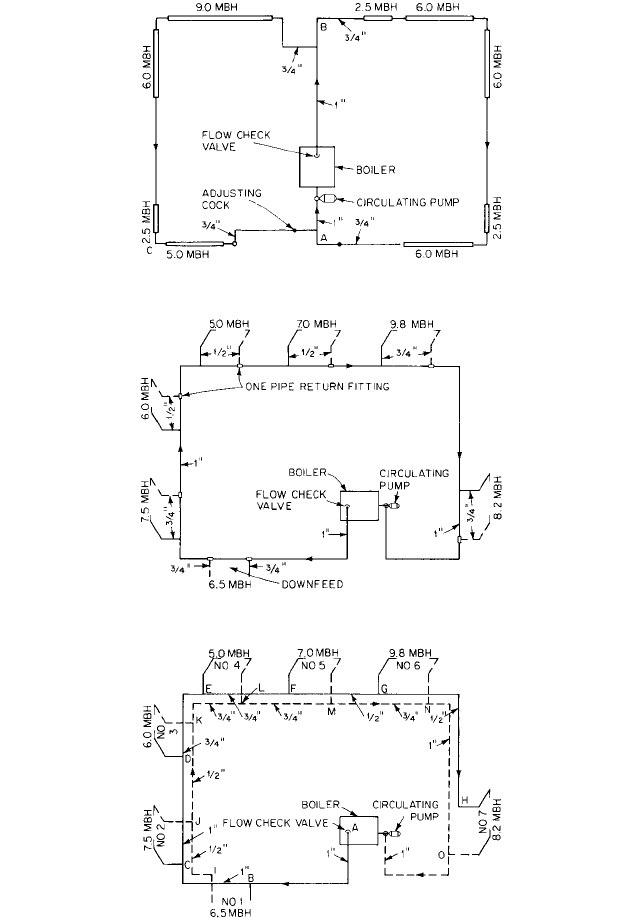
9.12 REFRIGERATION, HEATING, AND AIR CONDITIONING 9.255
FIGURE 1 A series loop system
FIGURE 2 A one-pipe system
FIGURE 3 A two-pipe reverse-return system.A circuit with primary-secondary pumping provides variable
temperature at constant flow rate for two or more coils.
Types of Water Circuit There are several types of water circuits. Those shown in Fig-
ures 1 and 2 are suitable for smaller systems and can be used for larger systems by hav-
ing several of these circuits in parallel. The one shown in Figure 3 is suitable for small or
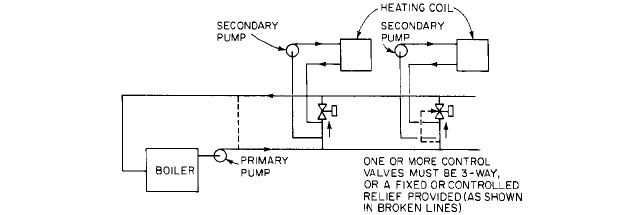
9.256 CHAPTER NINE
FIGURE 4 A circuit with primary-secondary pumping to provide variable temperature at constant flow rate for
two or more coils
very large circuits, but the reverse return would add considerably to the cost if the circuit
extended in one direction instead of in a practically closed loop as shown. For the extended
circuit, a simple two-pipe circuit, with proper design for balancing, would be used.
There are a number of reasons for using other circuits, particularly primary-secondary
pumping where the system is more extended or complicated, such as continuous circula-
tion branches with controlled temperature. When a coil heats air, part or all of which may
be below freezing, the velocity of the water in the tubes and its temperature at any point
in the coil must be such that the temperature of the inside surface of the tube is not below
freezing. The circuit shown in Figure 4 makes this possible.
Primary-secondary pumping permits flow rates and temperatures in branch circuits to
be different from those in the main circuit without the flow and pressure differences in the
mains or branches having a significant effect on each other. There are many possible
primary-secondary circuits to meet different requirements.
Steam Heating Systems No pumping is required with the smallest and simplest steam
systems if there is sufficient level difference between the boiler and condensers (radia-
tors, heating coils, and so on) to provide the required flow. When insufficient head exists
between the level of the condensate in the condenser and the boiler to produce the
required flow to the boiler, a pump must be introduced to provide the required head.
Because the condensate in the hot well will be at or near its saturation temperature and
pressure, the only NPSH available to the pump will be the submergence less the losses
in the piping between the hot well and the pump. A pump must be selected that will oper-
ate on these low values of NPSH without destructive cavitation.
In many cases, particularly for very large systems, vacuum pumps are used to remove
both the condensate and air from the condensers. This permits smaller piping for the
return of condensate and air, more positive removal of condensate from condensers, and,
when high vacuums
—
above 20 in (0.5 m)
—
are possible, some control of the temperature
at which the steam condenses. The use of vacuum return, particularly with higher vacu-
ums, helps reduce the possibility of frozen heating coils exposed to outside air or to strat-
ified outside and recirculated air. Vacuum return pumps are available for handling air and
water. Vacuum, condensate, and boiler-feed pumps with condensate tanks are all available
in package form.
Most condensate pumps are centrifugal. Vacuum pumps may be rotary, including a
rotary type with a water seal and displacement arrangement.
Fuel Oil When oil burners are fairly far from the oil storage tank or when there are a
number of burners at different locations in a building, a fuel oil circulating system is
required. The flow rate is relatively low
—
1 gpm (3.8 liters/min) would provide more than
8,000,000 Btu/h (560,000 Gcal/s or 2,343,000 W)
—
and a small gear pump is usually used.
9.12 REFRIGERATION, HEATING, AND AIR CONDITIONING 9.257
AIR CONDITIONING __________________________________________________
Many air conditioning systems produce chilled water at a central location and distribute
it to air cooling coils in various locations throughout the building or group of buildings.
Centrifugal pumps are particularly well suited for this service.
The type of circuit and the number of pumps used require an evaluation of several
factors:
1. The cooling requirements usually vary over a wide range.
2. Flow rate through a chiller must be kept above the low point where freezing would be
possible and below the point where tube damage would result. Some methods of
chiller capacity control require a constant flow rate through the chiller.
3. The temperature of the surface cooling the air must be low enough to control the rel-
ative humidity.
3
This limits the use of parallel circuits through chillers when one cir-
cuit may not be in operation and permits unchilled water to mix with water in the
operating chiller. Under these conditions, it is difficult or impossible to attain a suffi-
ciently low mixture temperature and the control of flow rate and water temperature
in the air cooling coils is limited.
4
4. Below-freezing air may sometimes pass over all or part of a coil. This condition would
require a flow rate and water temperature adequate to keep the temperature of all
water-side surfaces of tubes above freezing. Many water circuits are available to
achieve the desired results. For control of the relative humidity, the air flow circuit
must also be considered. Figure 5 shows a circuit for cooling coils with a variable air
flow rate at constant air-leaving temperature and with two chillers in series. In addi-
tion, the two chillers are shown in parallel with a third chiller. This arrangement per-
mits continuous flow through the coils to reduce the possibility of freezing when the
average temperature of the air entering the coil is above freezing, but the usual strat-
ification results in a below-freezing temperature for some of the air entering the coil.
The word reduce is used because full prevention requires appropriate air flow pat-
terns, water velocities, and temperatures to assure that the water side of the surface
will not be below freezing at any point in the coil. One of the coils is also arranged to
add heat whenever the temperature of the air leaving the coil must be above that of
the average air-entering temperature. Some circuits attempt to obtain the desired
results from the circuit in Figure 5 with fewer pumps. However, the use of fewer
pumps, although it would reduce the cost slightly, would also require three-way
instead of two-way valves, would make control somewhat more complicated, and
would almost certainly result in greater power consumption. The circuit shown per-
mits pump heads to match the requirements exactly. It also permits stopping an indi-
vidual pump when flow is not required in one of the circuits; two-way valves 1, 2, and
3 will reduce pump circulation and the power of pump 3 at partial cooling load.
Air Separation and Removal The methods for handling air with chilled water are
about the same as those for hot water except that there is not usually a rise in tempera-
ture above that of the make-up water to produce additional separation of air. An expan-
sion tank is required, but the reduced temperature difference requires a much smaller
tank than with hot water.
Condenser Water Circulation Condenser water may be recirculated and cooled by
passing through a cooling tower, or it may be pumped from a source such as a lake,
ocean, or well.
Cooling Tower Water Centrifugal pumps are used for circulating cooling tower water.
The circuit, which is open at the tower where the water falls or is sprayed through the
air, transfers heat to the air before the water falls to the pan at the base of the tower. A
pump then circulates the water through the condenser, as shown in Figure 6. In this case,
the pump must operate against a head equal to the resistance of the condenser and pip-
ing plus the static head required to the tower from the water level in the pan.
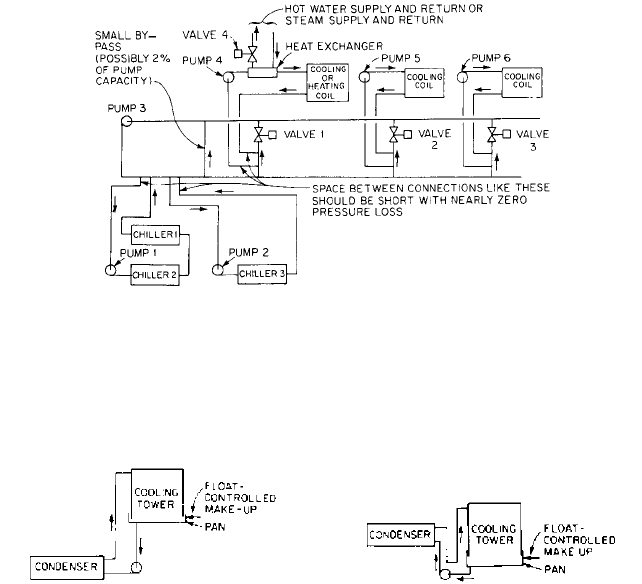
9.258 CHAPTER NINE
FIGURE 5 Pump 3 does not operate unless pump 1 or pump 2 operates. Pump 1 operates only if chiller 1 or
chiller 2 is required and operating. Pump 2 operates only if chiller 3 is required and operating. Pump 4 operates
when air circulates over the coil to which the pump is connected, if cooling or heating is required, or if any air
enters this coil below about 35°F (12°C). Pumps 5 and 6 operate in the same manner for the coils to which they are
connected. Operation of pumps 4, 5, and 6 helps to equalize the temperature of air streams that enter the coils at
different temperatures, and thus it may be desirable to operate these pumps continuously when air circulates over
the coils. Valves 1 and 4 are interlocked, and so one must be closed before the other can open. Also, valve 1 should
be prevented from opening if the temperature of the water in the pump 4 circuit is above about 90°F (32°C).
FIGURE 6 Cooling tower with condenser below pan
water level
FIGURE 7 Cooling tower with condenser above pan
water level
Figure 7 shows a somewhat similar circuit except that here the condenser level is
above the pan water level. The size of the pan of a standard cooling tower is sufficient to
hold the water in the tower distribution system so the pan will not overflow and waste
water each time the pump is shut down. This capacity also assures that the pan will have
enough water to provide the amount required above the pan level immediately after start-
up, without waiting for the make-up that would be needed if there was any overflow when
the pump stopped. When the condenser or much of the piping is above the pan overflow,
the amount draining when the pump is stopped will exceed the pan capacity unless means
are provided to keep the condenser and lines from draining. In Figure 7, it will be noted
that the line from the condenser drops below the pan level before rising at the tower. This
keeps the condenser from draining by making it impossible for air to enter the system.
This is effective for levels of a few feet, but useless if the level difference approaches the
barometric value. Such large level differences should be avoided if possible because they
require special arrangements and controls.
When a cooling tower is to be used at low outside temperatures, it is necessary to avoid
the circulation of any water outside unless the water temperature is well above freezing.
The arrangement shown in Figure 8 provides this protection. The inside tank must now
provide the volume previously supplied by the pan, in addition to the volume of the piping
from the tower to the level of the inside tank. Condensers or piping above the new over-
flow level must be treated as already described and illustrated in Figure 7, or additional
tank volume must be provided.
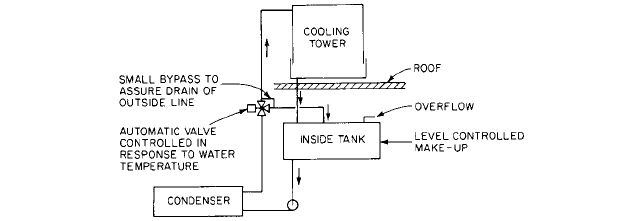
9.12 REFRIGERATION, HEATING, AND AIR CONDITIONING 9.259
FIGURE 8 Cooling tower with inside tank to permit operation when outside wet-bulb temperatures are below
freezing
The only portion of the inside tank that will be available for the water that drains down
after the pump stops is that above the operating level. This level is fixed by the height of
liquid required to avoid cavitation at the inlet to the pump. The suction piping to the pump
must remove only water from the tank without air entrainment.
5
The size of this pipe at
the tank outlet should be determined not by pressure loss but by the velocity that can be
attained from the available head. Exact data on this are not available, but the required
velocity at the vena contracta (about 0.6 of the pipe cross-sectional area) can be calculated
from V (2gh)
1/2
where h is the height of the operating level above the vena contracta. The
outlet from the tank should be at least as large as that from the cooling tower.
Well, Lake, or Sea water Centrifugal pumps are used for all of these services. The level
from which the water is pumped is a critical factor. The level of the water in a well will
be considerably lower during pumping than when the pump does not operate. When
pumping is from a lake or from the ocean, the drawdown is usually not significant. When
pumping is from a pit where the water flows by gravity, there will be a drawdown that
will depend on the rate of pumping.With a sea water supply, there will be tidal variations.
A lake supply may have seasonal level differences.
All these factors must be taken into consideration in selecting the level for mounting
the pump to assure that it will be filled with water during start-up. Check or foot valves
may be used for this purpose.Also, the head of the water entering the pump at the time of
highest flow rates must not be so low that the required NPSH is not available.
To assure proper pump operating conditions, the pump is frequently mounted below
the lowest level expected during zero flow conditions, as well as below the lowest level
expected at the greatest flow rate. These conditions may require a vertical turbine pump.
The motor should be above the highest water level with a vertical shaft between the motor
and the pump bowls, or the motor can be of the submerged type and connected directly to
the pump bowls.
Refrigeration For refrigeration systems with temperatures near or below freezing,
pumps are often required for brine or refrigerant circulation. The transfer of lubrication
oil also frequently requires pumps.
Brine Circulation The word brine, as used in refrigeration, applies to any liquid that
does not freeze at the temperatures at which it will be used and which transfers heat
solely by a change in its temperature without a change in its physical state. As far as
pumping is concerned, brine systems are very similar to systems for circulating chilled
water or any liquid in a closed circuit. A centrifugal pump is the preferred choice for this
service, but it must be constructed of materials suitable for the temperatures encountered.
For some brines, the pump materials must be compatible with other metals in the system
to avoid damage from galvanic corrosion.
Tightness is usually more important in a brine circulating system than in a chilled
water system.This is true not only because of the higher cost of the brine but also because
